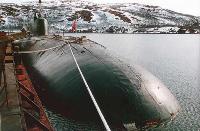
New Managing Director for Bellona Norway
The Board of the Bellona Foundation has appointed former Minister of Climate and the Environment Sveinung Rotevatn as Managing Director of Bellona No...
News

Publish date: February 14, 2003
News
In the 1980s, Ara Bay was a relatively large navy base serving nuclear submarines of all three generations; however, in recent years, the base has decreased in importance. There are at least 17 nuclear submarines laid-up at the base at this time, of Echo II class and Charlie-II class. Between them, these submarines account for at least 30 naval reactors, all of which still contain their fuel. The remaining active submarines that are based here are Akula class, Sierra class and Oscar II class. The base at Ara Bay is one of the most poorly equipped bases of the Northern Fleet.
The nuclear submarine K-192 (formerly K-131), which suffered a reactor accident in June 1989, was laid-up at Ara Bay until 1994. Since it was in danger of sinking there at the pier, it was moved to Shipyard No. 10 Shkval at Polyarny. However, 74 TBq (2,000 Ci) was released to the sea in connection with the accident, and an area of 1 km² in Ara Bay was contaminated by radioactivity.
Three tunnels originally intended to conceal nuclear submarines have been blasted out at the naval base in Ara Bay. These tunnels are 30 metres in diameter and each one measures 400 metres in length. None of them has been completed. For many years there have been plans to use these tunnels to store reactor compartments from dismantled submarines. The use of the tunnels was intended as a temporary measure until a permanent repository for radioactive waste could be established in north-western Russia. A storage period of about 80-100 years for up to 100 reactor compartments is considered a realistic possibility; however, at the present time, there are no available funds to finance this project.
A Nurka type reactor is also stored at Ara Bay still containing its nuclear fuel. This type of reactor was intended to be installed in a diesel-powered submarine. It is not known whether or not the reactor was ever actually used.
It is believed that there is also a smaller storage area at Ara Bay for solid and liquid radioactive waste. In addition, there is a storage tank of 3m³ in volume that is used to collect liquid radioactive waste from submarines.
The base at Ura Bay is used for diesel submarines and a few smaller surface vessels.

The Board of the Bellona Foundation has appointed former Minister of Climate and the Environment Sveinung Rotevatn as Managing Director of Bellona No...

Økokrim, Norway’s authority for investigating and prosecuting economic and environmental crime, has imposed a record fine on Equinor following a comp...

Our op-ed originally appeared in The Moscow Times. For more than three decades, Russia has been burdened with the remains of the Soviet ...

The United Nation’s COP30 global climate negotiations in Belém, Brazil ended this weekend with a watered-down resolution that failed to halt deforest...